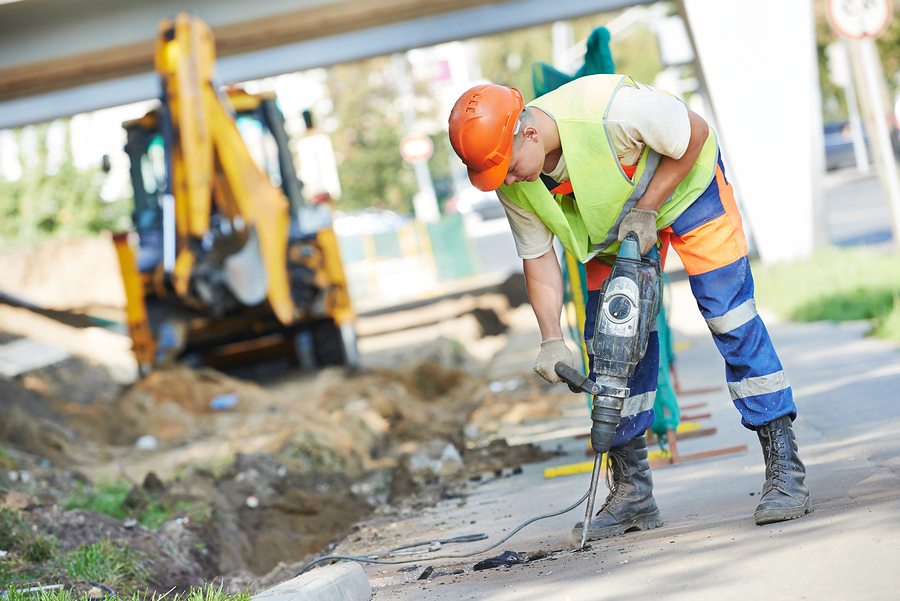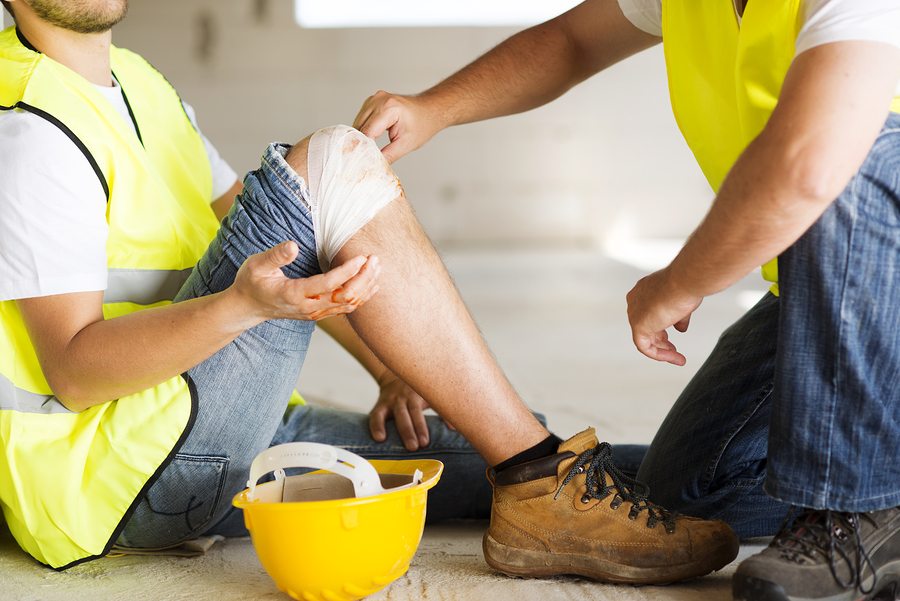by jeffp | Oct 14, 2015 | Construction

While accidents can occur on any jobsite, demolition workers face a number of unique hazards ranging from encounters with unknown materials and design modifications to building deterioration. These hazards can easily lead to death, as they did for a Chicago construction worker earlier this year (struck by falling concrete) and six Philadelphia demolition workers last June (buried by a collapsing building). Fortunately, following the Occupational Safety and Health Administration (OSHA) standards for demolition can greatly increase the safety of your employees.
Before beginning any demolition job, OSHA requires the demolition contractor to take a series of steps to protect workers at the jobsite. These preparatory requirements focus on the overall planning of the demolition job and include the actions described below.
- Conduct an engineering survey. A survey is necessary to determine the condition of the framing, floors and walls of the building so that precautions may be taken to prevent a premature collapse of any portion of the structure. It must also consider the previous use of any hazardous chemicals, gases, explosives or flammable materials on the site. Samples may need to be taken and analyzed prior to demolition.
In some cases the demolition contractor must survey adjacent structures as well. In addition, the information gathered in the written survey report will enable the contractor to ascertain the equipment and manpower requirements of the job as well as plan for protection of workers in the event of fires, cave-ins and injuries. Basic safety equipment needs—from respirators to eye protection—must also be determined at this time.
- Locate and prepare utilities. The demolition contractor must make sure all utility service lines—including electric, gas, water, sewer and steam—have been shut off, capped or otherwise controlled before the demolition begins. In most cases this requires the advance notification and assistance of the associated utility companies.
If power, water or another utility will be required during demolition activities, the lines must be relocated or protected. The contractor must inform all jobsite employees of the location of any existing or relocated utility lines.
- Arrange for prompt medical attention. The demolition contractor must locate the nearest hospital, clinic or physician with the capabilities necessary to provide medical attention in the case of serious injury. He must ensure the jobsite supervisor knows the most direct route to the nearest facilities as well as has the ability to contact an ambulance service from the demolition site. Telephone numbers for ambulances, hospitals, the local police and fire department must be publicized.
In the event that the demolition work is being completed at a site without easy access to hospitals or clinics, a person certified in first aid must be available to provide medical attention. Regardless of location, all demolition jobsites must have a properly stocked first aid kit that is checked weekly to allow for the replacement of expired items.
- Create a fire plan. Set up before the demolition job begins, the fire plan must outline the duties of key jobsite workers in the event of a fire as well as provide an evacuation plan for everyone on the site. The contractor must also ensure that adequate fire-fighting equipment is located near any flammable or combustible liquid storage area on the jobsite and only approved containers or tanks are used for the storage of such liquids.
During the demolition, workers must maintain free access from the street to fire hydrants and outside connections for sprinklers, standpipes and other permanent or temporary fire-extinguishing equipment. A temporary or permanent water supply must be available for the proper operation of fire-fighting equipment, and fully charged portable fire extinguishers should be placed throughout the jobsite.
For additional information regarding OSHA demolition safety requirements, visit their website at www.osha.gov.
by jeffp | Sep 25, 2015 | Construction

Construction sites are notoriously dangerous. But there are precautions you can take to help minimize the risks of injury. Here are the Top Ten Safety Concerns you shouldn’t overlook:
1. Scaffolding
Providing extensive scaffolding training for any workers who will use it is essential. Not all workers automatically know how to use scaffolding. They must be taught about the dangers of power lines, unstable platforms and falling debris. Be sure any suspended or supported scaffolds have guardrails. Scaffolding must always be strong enough to support at least four times the intended load.
2. Ladder Safety
Ladders should be visually inspected before each use. Show employees how the check the side rails, rungs and feet for damage or defects. All ladders’ side rails should extend no less than three feet above the ground, and the top must meet a sturdy support. Educate employees about the dangers of ladder misuse. Ladders should only have weight loads that they’re designed to support. Be sure they also comply with the OSHA’s 29 CFR 1926.1053(a)(1) regulation.
3. Personal Protective Equipment
Most employees know this term simply as PPE. This equipment is essential for protecting employees from various hazards. Latex gloves are used when handling chemicals, dust masks are worn when sawing and earplugs are worn when using noisy tools. Hard hats and goggles are usually worn at all times to protect workers from dangerous falling or flying objects. OSHA requires employers to provide PPE when it is essential for the workplace. Construction sites are never an exception to this rule. Many employees find these accessories uncomfortable to wear. To prevent them from refusing to wear PPE, employers should offer comfortable equipment that specially made.
4. Confined Space Safety
Working in a small space may result in injury or death from being exposed to a toxic, combustible or oxygen-deficient atmosphere. Such spaces should always be connected to a reliable monitoring system. Employees exposed to the area should also be educated about the risks and how to identify them. Be sure to implement a Lockout/Tagout system to protect workers from unwanted starting of dangerous machines. To learn more about this system’s regulations, read the 29 CFR 1910.147 OSHA regulation. Compliance with this standard prevents approximately 55,000 injuries and 120 deaths annually.
5. Welding Safety
Eye injuries and burns happen to welders too often. These injuries may cause extended damage or permanent disfigurement. By making sure welding employees always wear the right PPE, this risk is reduced greatly. To prevent welders from refusing PPE, be sure their equipment is paid for, comfortable and fits properly. Be sure to provide them with flame-retardant clothing also. ANSI Z87.1 rules that helmets are essential. They are a secondary form of eye protection, so goggles or glasses must also be worn. It’s also essential to ensure there are fans or ventilation systems in place to reduce the risk of airborne hazards.
6. Fall Protection
In addition to providing fall prevention training, employers should conduct a test or review of employees’ knowledge. It’s important to ensure that they know how to prevent themselves from falling. Develop an efficient safety plan that includes a team effort.
Be sure to have fall protection equipment checked regularly. Observe it after each use for any apparent damage. In addition to this, have the equipment inspected and documented annually. Remember to keep OSHA regulations in mind for inspections and documentation.
7. Respiratory Safety
This safety issue is serious enough that OSHA developed many regulations about it. The types of chemicals, dust or other harmful substances that cause respiratory problems may vary from one work site to another. However, there are precautions that must be taken to avoid overexposure or accidental inhalation of a substance.
OSHA’s 29 CFR 1910.134 regulation details respiratory safety standards. Employers should always have a work site assessed by an occupational health specialist to determine the risk of exposure to harmful substances. In addition to this, contact a personal business insurance company to find out what their rules about harmful substance exposure are.
8. First Aid & Fire Safety
Since the risk for injuries is higher in the construction field, it’s essential for employees to know first aid. Show them how to use kits, how to treat common injuries and how to prevent infections. They should also be instructed to report their injuries, however small or large, to their supervisor. Show them how to use eyewash stations, burn kits and emergency drench showers. Be sure they know how to use a fire extinguisher and are familiar with evacuation plans. Conducting regular fire drills is a safety essential.
9. Proper Documentation
Not only is thorough documentation required by OSHA but it’s also required by the law. In the unfortunate event of injuries or fatalities, it’s imperative to have thorough documentation of everything. Investigations are common in legal proceedings, so having a lack of documentation may place an employer in a bottomless pit of problems. Always keep injury logs, work logs and employee injury records current.
10. Safety Training
Be sure to provide ample training for employees. Weekly safety meetings, monthly seminars and voluntary training classes should all be established. OSHA offers an outreach training program that is voluntary. To give employees the chance to complete it, contact OSHA to receive complete information about the program.
by jeffp | Sep 10, 2015 | Construction

Signed into law on March 23, 2010, the Patient Protection and Affordable Care Act, often referred to as the ACA, included reforms intended to improve Americans’ access to affordable health coverage while prohibiting abusive insurance company practices. A number of the provisions within the ACA have gone into effect—in 2014 and 2015 that directly relate to your construction business. Here are the biggest ones you need to be aware of as a construction employer.
Mandatory Affordable Health Coverage
If your construction company employs 50 or more full time and full time equivalent workers, you must provide them with health coverage. Should you fail to do so, the ACA requires you to pay a $167 penalty for each full time employee in excess of 30. You must pay this penalty monthly if even one of your full time workers purchases federally subsidized coverage through the exchange.
If the requirements of the ACA classify the health coverage you provide as unaffordable (costing more than 9.5 percent of annual household income), or should that health coverage fail to provide minimum value (covering less than 60 percent of health care expenses), you will also have to pay a monthly penalty of $250 for each full time worker who purchases federally subsidized coverage through the exchange.
These mandates went into effect January 2015. However, the government will use your 2014 payroll numbers to determine compliance. Note: while the employer-paid portion of your employees’ health insurance premiums is tax deductible, these penalties are not.
Full Time and Full Time Equivalent Employees
The Affordable Care Act defines full time employees as those who work at least 30 hour per week. However, you must also count part time workers when determining your construction company’s total number of employees. These workers’ monthly hours, when added together and divided by the number of part timers, becomes the number of full time equivalent employees you employ.
Seasonal Employment Spikes
In the construction industry, it’s quite common for employee numbers to fluctuate seasonally. Sometimes you may have 50 or more workers and fall under the “applicable large employer” definition—other times you may not. As such, you may be exempt from the ACA’s “pay or play” rule—provided your employee average does not exceed 50 for more than four months.
Calculating full time equivalent employees and determining whether your current health care plan is affordable and offers minimum value can be quite complicated. Consult your benefits manager or another knowledgeable expert for guidance and advice
by jeffp | Aug 26, 2015 | Construction

Excess noise is detrimental to health. Studies have found that noise causes the body to release stress hormones that increase the risk of heart attack and other health issues. This is true even when the noise levels are not extreme. For this reason, an important consideration in new home construction is noise abatement. Using construction techniques that insulate the homeowner from external noise sources can contribute to an environment that is relaxing and healthy.
Wall construction is the builder’s first line of protection against noise.
Choosing to decouple the framing in the walls is helpful because sound waves are no longer able to travel uninterrupted from one end of the wall to the other. This is only the first step, however. After the walls are framed, insulation should be added. Fiberglass insulation works well, but should not be packed in tightly, as it will then conduct sound rather than muffling it.
Add mass to the wall by using a heavy weight of drywall.
It is difficult for sound to move through heavy walls, which is why people who live in adobe or straw bale homes with thick walls report a great deal of protection from noise. In traditional construction, builders can add two 5/8” thick pieces of drywall to each wall for effective soundproofing. While additional layers may be added, the increased effectiveness will be minimal.
For additional soundproofing, use Green Glue between layers of drywall.
This product reduces both airborne and impact noise, and is easily applied with a standard caulk gun. Existing construction can be improved by using a layer of Green Glue to add additional sheets of drywall where needed. Use the glue to seal any gaps near the ceiling or floor, as leaving a gap will let in sound the same way leaving a window cracked on a cold day will allow cold air to enter the home.
Keep an eye on new developments in soundproofing technology, as new products are entering the market.
For example, the acoustics department at the Fraunhofer Institute for Building Physics IBP have recently developed microperforated construction components that work for a variety of applications. These components consist of sheets that are perforated with tiny slits that generate friction with the air carrying the sound wave, resulting in superior sound absorption.
It is likely that as public awareness of the importance of auditory health continues to build, that construction that has been built with noise abatement in mind will be more valued than structures that do not account for this issue.
by jeffp | Aug 12, 2015 | Construction

Any builder, whether constructing homes for a new subdivision or building a new home for his family, should consider getting builder’s risk insurance if he has not already done so. Not only does builder’s insurance cover the cost of the materials used to build the structure, but the cost of the labor as well. This provides contractors and other building professionals with peace of mind, knowing that a significant investment of time and materials will not be lost should the town be hit by a tornado, serial vandalism or other construction-wrecking malady.
Coverage
The typical builder’s risk insurance policy covers damage occurring in the event of theft, vandalism, vehicles, fire and explosions. It also covers loss from natural disasters such as lightning, hail and high winds. Check with your insurer to make sure a policy includes all of these things, as not all policies cover all possible scenarios.
Exclusions
Exclusions for this type of policy are numerous, and often include scenarios such as earthquake, water damage, war and employee theft. Builder’s risk insurance also does not typically cover contract penalties, mechanical breakdowns and the other risks you incur simply by doing business as a contractor.
Additional Coverage
Ask your insurance agent about coverage for specific scenarios you might be concerned about.
For example, in some areas, it is possible to obtain limited coverage in the event of earthquake. You can also ask that a policy provide coverage for building materials that are being transported from one location to another.
Exceptions
Note that builder’s risk insurance only covers the risk to you, not to others. It will not cover the theft of equipment left on the job site by a subcontractor, for example. It does not cover injuries suffered by others on your site. Tools and other equipment are not covered.
Once the building is complete, you will need to switch to a different policy, as builder’s risk insurance is only effective during the building process. Should anything happen during the construction phase, however, you are certain to be glad you had your investment covered.
by jeffp | Jul 29, 2015 | Construction

Your construction company has been in business for years. It is growing steadily, attracting talented workers, landing profitable projects, and, basically, putting your competitors to shame. Then something goes wrong. Not all at once, perhaps, but you begin to notice that things no longer feel right. Your profit margin is shrinking and your best workers are developing poor attitudes. Projects are no longer going smoothly, and it feels like you have to work harder than ever to get the same amount of work done. What is the problem?
The answer could be inefficiency, and it takes many forms. Fortunately, it’s also a problem with a solution—whether your leadership team or unaddressed sources of lean waste are to blame.
Start by Evaluating Your Team
In order to retain your status as a world-class contractor, you must build an exceptionally productive crew. Doing so requires creating a culture in which everyone—from the executives to the foremen and the construction workers—are dedicated to operational effectiveness and vigilantly prevent inefficiencies.
Training is a necessary investment—in both soft (or “people”) skills as well as the technical—especially when it comes to leadership positions. Strong teams require strong leaders, so you’ll need to evaluate your own management style as well as the strengths and weaknesses of the other key players in your construction company. Retrain as necessary.
Look for Sources of Waste
Waste often starts out as a minor issue. However, left unchecked, it can become a major problem. Make sure your foremen, superintendents, project managers and other leaders know how to spot the types of waste common in construction.
- Transportation waste due to moving things more often or further than necessary. Every time you move materials or equipment, you use resources and increase the risk of damage losses.
- Inventory waste due to excessive material purchases. When you buy too many materials, you spend more than necessary. You also spend more storing it, handling it and returning it.
- Motion waste due to people moving around more than necessary. Time is money, and covering distance—such as from a work area to a break area or restroom that is unnecessarily far away—creates waste.
- Waiting waste due to crew needing to wait for tools, equipment or information.
- Overproduction waste due to one crew working faster than the others (which generally leads to waiting waste).
- Defect waste due to shoddy craftsmanship or materials. Repairing defects will cost you more in time, labor and materials.
If your leadership team knows how to identify inefficiencies, they can then look for the root causes and eliminate them.








